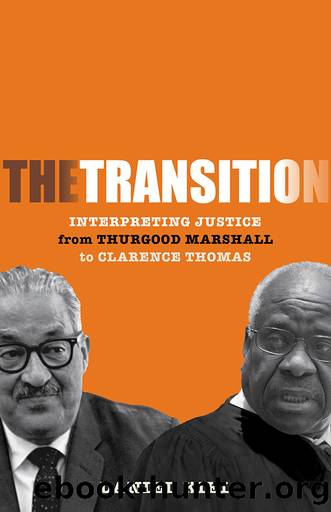The Transition by Daniel Kiel

Author:Daniel Kiel
Language: eng
Format: epub
Publisher: Stanford University Press
Published: 2023-06-15T00:00:00+00:00
ELEVEN
PUTTING THE GENIE BACK IN THE BOTTLE
In Kansas City, Missouri, residents would have readily related to Justice Marshallâs admonition in Milliken about administrative âfences to separate the races.â Troost Avenue was just such a fence. A boulevard stretching south from the cityâs central business district, Troost served as the de facto barrier between Black and white students in Kansas City. Echoing Marshallâs language, the road became known locally as the Troost Wall.1
Troost was one of a variety of walls dividing metropolitan Kansas City. In addition to the avenue within the city limits, the metropolitan areaâlike Detroitâhad many growing suburban municipalities as well as the state border between Kansas and Missouri. Discriminatory housing practices and school assignment policies organized around each of these fences ensured the perpetuation of racially identifiable neighborhoods and schools. In the two decades after Brown, over a dozen elementary schools east of Troost transitioned from entirely serving white students to serving a student population that was more than 90 percent Black; meanwhile, in a school district that had become nearly two-thirds African American, all but one of the elementary schools west of Troost served student populations that were less than one-quarter Black. As in Detroit, the increasing racial identifiability of the entire districtâthe schools had been 16 percent African American in 1954âreflected a racialized sorting within the broader metropolitan area.2
After being pushed by a growing coalition of African Americans within the city, the Kansas City Missouri School District (KCMSD) sued just about every governmental entity it could in May 1977 to seek assistance in breaking up the districtâs increasing segregation. Among the defendants were the federal government, the states of Kansas and Missouri, and eighteen suburban school districts in both states. The case, Missouri v. Jenkins, would reach the Supreme Court on multiple occasions, including on either side of the 1991 transition from Justice Marshall to Justice Thomas. When the case reached the Court in 1995, Justice Thomas authored a concurrence that articulated his deep skepticism of government interventions, a philosophy born, like the case itself, during Thomasâs time in Missouri in the 1970s. In so doing, Thomas, who was sitting for the Missouri bar in 1974 while Marshall was dissenting in Milliken, would help complete the work (begun by Nixonâs appointees in Milliken) of reining in the power of federal judges in desegregation cases.3
ACCEPTING CONSERVATISM
While Clarence Thomas was a law student at Yale, someone gave him a copy of the book Black Education: Myths and Tragedies by Thomas Sowell. Thomas âskimmed it angrily and threw it in the trash.â4 Like Thomas, Sowell was born into a rural southern family and had worked to earn admission into the most elite of American institutions. His family had left sharecropping in North Carolina when he was 8 as part of the Great Migration, and after a stint in the military, Sowell enrolled at Howard University before transferring to Harvard. From there, he went on to earn a PhD in economics from the University of Chicago, studying with the conservative economist Milton Friedman.
Download
This site does not store any files on its server. We only index and link to content provided by other sites. Please contact the content providers to delete copyright contents if any and email us, we'll remove relevant links or contents immediately.
The European History Highway: A Guide to Internet Resources by Dennis A. Trinkle Scott A. Merriman(494)
The Seven Wonders of the Ancient World by Michael Denis Higgins(477)
European Security in a Global Context by Thierry Tardy(470)
European Security without the Soviet Union by Stuart Croft Phil Williams(469)
The Routledge companion to Christian ethics by D. Stephen Long Rebekah L. Miles(458)
Hudud Al-'Alam 'The Regions of the World' - a Persian Geography 372 A.H. (982 AD) by V. V. Minorsky & C. E. Bosworth(399)
Gorbachev And His Generals by William C. Green(391)
Get Real with Storytime by Julie Dietzel-Glair & Marianne Crandall Follis(390)
Tibetan Studies in Comparative Perspective by Chih-yu Shih Yu-Wen Chen(385)
Governance, Growth and Global Leadership by Espen Moe(381)
Hyperculture by Byung-Chul Han(378)
CliffsNotes on Fitzgerald's The Great Gatsby by Kate Maurer(360)
The Oxford History of the World by Fernández-Armesto Felipe;(354)
How Languages Are Learned 5th Edition by Patsy M Lightbown;Nina Spada; & Nina Spada(353)
The Egyptian Economy, 1952-2000 by Khalid Ikram(352)
Oral Poetry and Narratives from Central Arabia: The Poetry of Ad-Dindan : A Bedouin Bard in Southern Najd (Studies in Arabic Literature, Vol 17) (English and Arabic Edition) by P. M. Kupershoek P. Marcel Kurpershoek(343)
The Oxford Handbook of the Incas by Sonia Alconini(333)
Europe Contested by Harold James(319)
The Hutchinson Dictionary of Ancient and Medieval Warfare by Peter Connolly John Gillingham John Lazenby(305)
